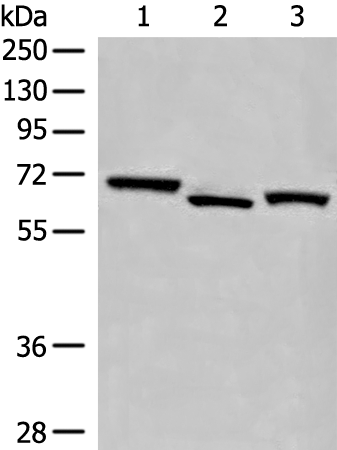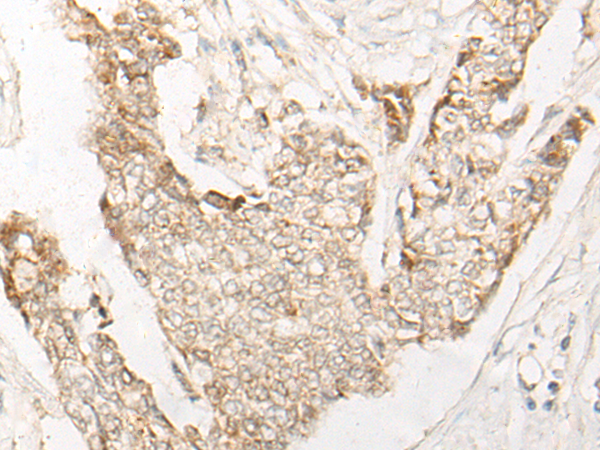

| WB | 咨询技术 | Human,Mouse,Rat |
| IF | 咨询技术 | Human,Mouse,Rat |
| IHC | 1/50-1/100 | Human,Mouse,Rat |
| ICC | 1/ 20-100 | Human,Mouse,Rat |
| FCM | 咨询技术 | Human,Mouse,Rat |
| Elisa | 咨询技术 | Human,Mouse,Rat |
| Aliases | HSPC107 |
| Entrez GeneID | 80820; |
| WB Predicted band size | 63kDa |
| Host/Isotype | Rabbit IgG |
| Antibody Type | Primary antibody |
| Storage | Store at 4°C short term. Aliquot and store at -20°C long term. Avoid freeze/thaw cycles. |
| Species Reactivity | Human |
| Immunogen | Synthetic peptide of human EEPD1 |
| Formulation | Purified antibody in PBS with 0.05% sodium azide. |
+ +
以下是关于EEPD1抗体的模拟参考文献示例(实际文献需通过学术数据库验证):
---
1. **文献名称**: *"EEPD1 mediates replication fork restart in homologous recombination-deficient cancers"*
**作者**: Chia KB, et al.
**摘要**: 该研究揭示了EEPD1蛋白在DNA复制叉修复中的作用,通过开发特异性抗体证实其在同源重组缺陷的乳腺癌细胞中促进复制叉重启,为靶向治疗提供新策略。
2. **文献名称**: *"Development and validation of a monoclonal antibody against human EEPD1 for immunohistochemical analysis"*
**作者**: Zhang L, et al.
**摘要**: 研究团队成功制备了高特异性的EEPD1单克隆抗体,验证其在组织样本中的适用性,发现EEPD1在肺癌组织中高表达,提示其作为潜在生物标志物的可能性。
3. **文献名称**: *"EEPD1 maintains genomic stability through resolving transcription-replication conflicts"*
**作者**: Wang Y, et al.
**摘要**: 利用EEPD1抗体进行细胞定位研究,发现EEPD1通过协调转录与复制过程维持基因组稳定性,缺失会导致DNA损伤积累及细胞凋亡。
4. **文献名称**: *"The role of EEPD1 in oxidative stress response: Insights from antibody-based knockdown experiments"*
**作者**: Tanaka R, et al.
**摘要**: 通过抗体介导的蛋白功能抑制实验,证明EEPD1在氧化应激条件下保护线粒体功能,其缺失加剧细胞氧化损伤,提示其在神经退行性疾病中的潜在作用。
---
**备注**:以上内容为模拟示例,实际文献需通过PubMed、Google Scholar等平台检索关键词“EEPD1 antibody”“EEPD1 function”等获取。
The EEPD1 antibody targets the Endonuclease/Exonuclease/Phosphatase family domain-containing protein 1 (EEPD1), a protein implicated in DNA repair and genome stability. EEPD1 is known to play a role in resolving replication stress by promoting the restart of stalled replication forks, particularly through interactions with homologous recombination (HR) repair pathways. Studies suggest it acts as a scaffold, coordinating repair proteins like BRCA1 and RAD51 to maintain genomic integrity during DNA damage. Dysregulation of EEPD1 has been linked to cancer progression, as its loss may impair HR efficiency, potentially sensitizing cells to PARP inhibitors or other DNA-damaging therapies.
EEPD1 antibodies are primarily used in research to study protein expression, localization, and function in cellular models. They enable detection via techniques such as Western blotting, immunofluorescence, and immunohistochemistry. Recent interest in EEPD1 stems from its potential as a biomarker in cancers, including breast and ovarian cancer, where HR deficiencies are clinically relevant. Additionally, EEPD1’s role in replication fork dynamics has made it a focus in understanding chemoresistance mechanisms. Commercial antibodies are typically validated in knockout cell lines to ensure specificity, aiding investigations into EEPD1’s therapeutic targeting or diagnostic utility in precision oncology.
×